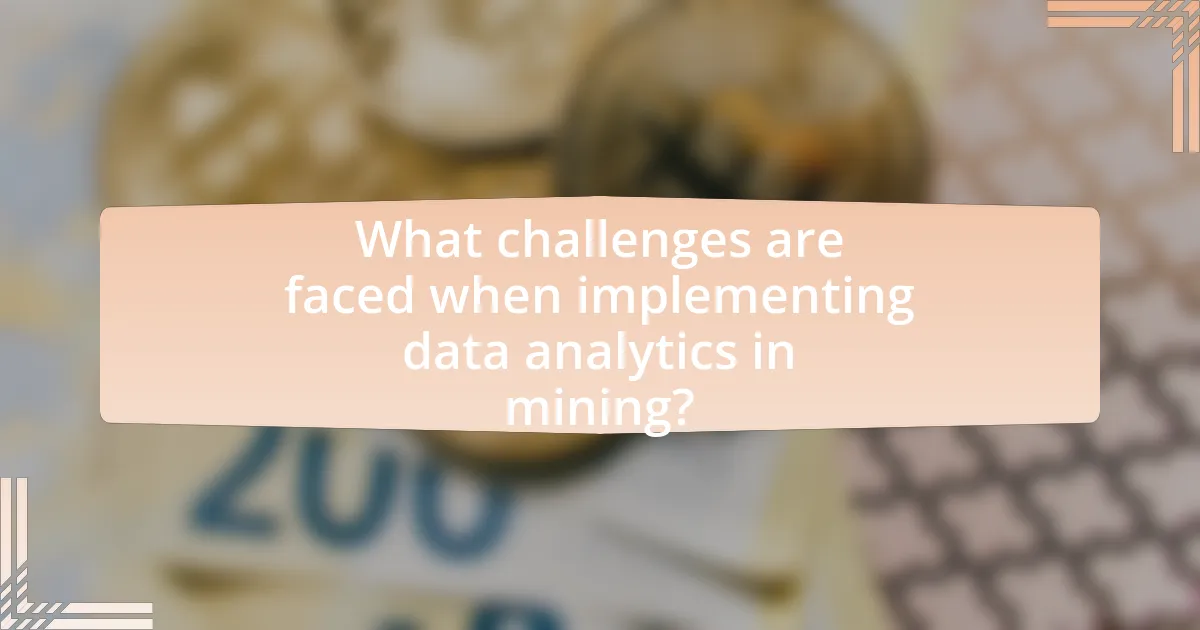Leveraging data analytics for improved mining performance involves the application of advanced analytical techniques to enhance operational efficiency, safety, and productivity within the mining sector. The article explores how data analytics can optimize resource extraction, improve decision-making, and reduce costs through predictive analytics, machine learning, and data visualization. Key benefits include increased productivity, enhanced safety measures, and effective resource management, while challenges such as data integration and quality are also addressed. Additionally, the article highlights future trends, including the integration of artificial intelligence and the Internet of Things, which are shaping the landscape of data analytics in mining.

What is Leveraging Data Analytics for Improved Mining Performance?
Leveraging data analytics for improved mining performance involves utilizing advanced analytical techniques to enhance operational efficiency, safety, and productivity in mining operations. By analyzing large datasets from various sources, such as equipment sensors, geological surveys, and production metrics, mining companies can identify patterns, predict equipment failures, and optimize resource allocation. For instance, a study by McKinsey & Company found that data analytics can increase productivity in mining operations by up to 20% by enabling better decision-making and reducing downtime. This demonstrates that effective use of data analytics directly correlates with enhanced performance in the mining sector.
How does data analytics enhance mining operations?
Data analytics enhances mining operations by optimizing resource extraction and improving operational efficiency. By analyzing large datasets from various sources, mining companies can identify patterns and trends that inform decision-making processes. For instance, predictive analytics can forecast equipment failures, allowing for proactive maintenance and reducing downtime. According to a report by McKinsey & Company, mining companies that leverage data analytics can increase productivity by 20-30% through improved operational insights and resource management. This data-driven approach leads to more efficient use of resources, reduced costs, and enhanced safety measures in mining operations.
What specific data analytics techniques are used in mining?
Specific data analytics techniques used in mining include predictive analytics, machine learning, and data visualization. Predictive analytics utilizes historical data to forecast future outcomes, enabling mining companies to optimize operations and reduce costs. Machine learning algorithms analyze large datasets to identify patterns and anomalies, improving decision-making processes. Data visualization techniques present complex data in an accessible format, facilitating better understanding and communication of insights among stakeholders. These techniques collectively enhance operational efficiency and safety in mining operations.
How do these techniques improve decision-making in mining?
Data analytics techniques improve decision-making in mining by providing actionable insights derived from vast amounts of operational data. These techniques enable mining companies to analyze geological data, equipment performance, and market trends, leading to more informed choices regarding resource allocation, risk management, and operational efficiency. For instance, predictive analytics can forecast equipment failures, allowing for timely maintenance and reducing downtime, which is crucial for maintaining productivity. Additionally, data visualization tools help stakeholders understand complex data sets, facilitating quicker and more accurate decision-making processes.
What are the key benefits of leveraging data analytics in mining?
Leveraging data analytics in mining provides significant benefits, including enhanced operational efficiency, improved safety, and optimized resource management. Data analytics enables mining companies to analyze vast amounts of data from various sources, leading to better decision-making processes. For instance, predictive analytics can forecast equipment failures, reducing downtime by up to 30%, as reported by the International Council on Mining and Metals. Additionally, data-driven insights can help in identifying the most productive mining sites, thereby increasing yield and reducing costs. These benefits collectively contribute to a more sustainable and profitable mining operation.
How does data analytics contribute to cost reduction in mining?
Data analytics contributes to cost reduction in mining by optimizing operational efficiency and resource allocation. By analyzing data from various sources, mining companies can identify inefficiencies in processes, reduce equipment downtime, and enhance predictive maintenance strategies. For instance, a study by McKinsey & Company found that data analytics can improve productivity in mining operations by 20-30%, leading to significant cost savings. Additionally, real-time data analysis allows for better decision-making regarding resource extraction, which minimizes waste and maximizes yield, further driving down costs.
What impact does data analytics have on safety and compliance in mining?
Data analytics significantly enhances safety and compliance in mining by enabling real-time monitoring and predictive analysis of operational risks. By analyzing data from various sources, such as equipment sensors and environmental conditions, mining companies can identify potential hazards before they lead to incidents. For instance, a study by the International Council on Mining and Metals found that companies using data analytics reported a 30% reduction in workplace accidents due to improved risk management practices. This proactive approach not only ensures compliance with safety regulations but also fosters a culture of safety within the organization, ultimately leading to better operational performance and reduced liability.

What challenges are faced when implementing data analytics in mining?
Implementing data analytics in mining faces several challenges, including data integration, data quality, and workforce skills. Data integration is difficult due to the diverse sources of data generated from various mining operations, which often use incompatible systems. Data quality issues arise from incomplete or inaccurate data, leading to unreliable analytics outcomes. Additionally, there is a shortage of skilled personnel who can effectively analyze and interpret complex data sets, which hinders the successful application of data analytics in mining. These challenges are well-documented in industry reports, such as the “Mining Industry Data Analytics” report by Deloitte, which highlights the critical need for improved data management and skilled workforce development to leverage analytics effectively.
What are the common obstacles to data integration in mining?
Common obstacles to data integration in mining include data silos, inconsistent data formats, and lack of standardization. Data silos occur when different departments or systems store data independently, making it difficult to access and analyze comprehensive datasets. Inconsistent data formats hinder the ability to merge information from various sources, as differing structures can lead to compatibility issues. Additionally, the lack of standardization in data collection and reporting practices across mining operations complicates integration efforts, resulting in fragmented insights and inefficiencies. These challenges are well-documented in industry reports, highlighting the need for cohesive data management strategies to enhance operational performance.
How can mining companies overcome data silos?
Mining companies can overcome data silos by implementing integrated data management systems that facilitate seamless data sharing across departments. These systems enable real-time access to information, allowing for better collaboration and decision-making. For instance, companies like Rio Tinto have adopted centralized data platforms that consolidate data from various sources, enhancing operational efficiency and reducing delays in information flow. By utilizing cloud-based solutions and standardized data formats, mining companies can ensure that all stakeholders have access to the same data, thereby breaking down silos and fostering a culture of data-driven decision-making.
What role does data quality play in analytics success?
Data quality is critical for analytics success as it directly influences the accuracy and reliability of insights derived from data analysis. High-quality data ensures that the analytics process produces valid results, which are essential for making informed decisions in mining performance. For instance, a study by the Data Warehousing Institute found that poor data quality can cost organizations up to 20% of their revenue, highlighting the financial impact of data inaccuracies. Therefore, maintaining high data quality is essential for effective analytics, enabling organizations to optimize operations and enhance performance in the mining sector.
How can mining companies ensure successful data analytics implementation?
Mining companies can ensure successful data analytics implementation by establishing a clear strategy that aligns data initiatives with business objectives. This involves identifying key performance indicators (KPIs) relevant to mining operations, investing in the right technology and tools for data collection and analysis, and fostering a data-driven culture among employees. For instance, a study by McKinsey & Company highlights that companies that integrate data analytics into their decision-making processes can improve productivity by up to 20%. Additionally, providing training and support for staff to effectively utilize data analytics tools is crucial for maximizing the benefits of data-driven insights.
What best practices should be followed for data analytics in mining?
Best practices for data analytics in mining include ensuring data quality, implementing advanced analytical techniques, and fostering a data-driven culture. Ensuring data quality involves regular data validation and cleansing to maintain accuracy and reliability, which is crucial for making informed decisions. Implementing advanced analytical techniques, such as machine learning and predictive analytics, allows mining companies to optimize operations, reduce costs, and enhance safety by predicting equipment failures and identifying operational inefficiencies. Fostering a data-driven culture encourages collaboration among teams and promotes the use of data in decision-making processes, leading to improved performance and innovation. These practices are supported by industry reports indicating that companies leveraging data analytics can achieve up to a 20% increase in productivity and a significant reduction in operational costs.
How important is employee training in leveraging data analytics?
Employee training is crucial in leveraging data analytics effectively. Well-trained employees possess the necessary skills to interpret data accurately, make informed decisions, and implement data-driven strategies. According to a study by McKinsey, organizations that invest in employee training for data analytics see a 20% increase in productivity and a 15% improvement in decision-making speed. This highlights that training not only enhances individual capabilities but also contributes significantly to overall organizational performance in data analytics.

What future trends are emerging in data analytics for mining?
Future trends in data analytics for mining include the integration of artificial intelligence (AI) and machine learning (ML) to enhance predictive maintenance and optimize resource extraction. These technologies enable mining companies to analyze vast amounts of data in real-time, leading to improved decision-making and operational efficiency. For instance, a report by McKinsey & Company highlights that AI can reduce operational costs by up to 20% through better predictive analytics and automation. Additionally, the use of Internet of Things (IoT) devices is on the rise, allowing for continuous monitoring of equipment and environmental conditions, which further supports data-driven strategies in mining operations.
How is artificial intelligence shaping data analytics in mining?
Artificial intelligence is significantly shaping data analytics in mining by enhancing predictive maintenance, optimizing resource allocation, and improving safety measures. AI algorithms analyze vast amounts of geological and operational data to predict equipment failures, which can reduce downtime by up to 30%, as reported by McKinsey & Company. Additionally, AI-driven analytics enable mining companies to optimize their supply chains and resource extraction processes, leading to cost reductions of approximately 10-15%. Furthermore, AI technologies contribute to safety by identifying potential hazards through real-time data analysis, thereby decreasing accident rates in mining operations.
What advancements in technology are influencing data analytics practices?
Advancements in technology influencing data analytics practices include artificial intelligence, machine learning, big data technologies, and cloud computing. Artificial intelligence and machine learning enhance predictive analytics by enabling algorithms to learn from data patterns, improving accuracy in forecasting outcomes. Big data technologies, such as Hadoop and Spark, facilitate the processing of vast datasets, allowing for real-time analytics and insights. Cloud computing provides scalable resources for data storage and processing, enabling organizations to analyze large volumes of data efficiently. These technologies collectively enhance the ability to derive actionable insights from data, thereby improving decision-making processes in various sectors, including mining.
How can predictive analytics transform mining operations?
Predictive analytics can transform mining operations by enhancing decision-making through data-driven insights. By analyzing historical data and identifying patterns, mining companies can forecast equipment failures, optimize resource allocation, and improve safety measures. For instance, a study by McKinsey & Company found that predictive maintenance can reduce equipment downtime by 30-50%, significantly increasing operational efficiency. Additionally, predictive analytics enables better planning of extraction processes, leading to a potential increase in yield by up to 10%. This data-centric approach not only boosts productivity but also minimizes costs and environmental impact, demonstrating the substantial benefits of integrating predictive analytics into mining operations.
What practical steps can mining companies take to leverage data analytics effectively?
Mining companies can leverage data analytics effectively by implementing advanced data collection systems, utilizing predictive analytics, and fostering a data-driven culture. Advanced data collection systems, such as IoT sensors and drones, enable real-time monitoring of mining operations, leading to improved decision-making. Predictive analytics can forecast equipment failures and optimize maintenance schedules, which reduces downtime and operational costs. Additionally, fostering a data-driven culture encourages employees to utilize data insights in their daily operations, enhancing overall productivity. According to a McKinsey report, companies that adopt data analytics can improve their productivity by 20-25%, demonstrating the tangible benefits of these practical steps.
How can mining companies start small with data analytics initiatives?
Mining companies can start small with data analytics initiatives by identifying specific operational challenges and utilizing basic data collection methods to address them. For instance, companies can begin by implementing simple data tracking systems for equipment performance or production metrics, which can be achieved with minimal investment in technology. According to a report by McKinsey & Company, even small-scale data analytics can lead to a 10-20% increase in productivity when focused on targeted areas. By gradually expanding their analytics capabilities based on initial findings, mining companies can build a robust data-driven culture without overwhelming resources.
What metrics should be tracked to measure the success of data analytics in mining?
To measure the success of data analytics in mining, key metrics include operational efficiency, cost reduction, safety improvements, and production yield. Operational efficiency can be quantified by tracking equipment utilization rates and downtime, which directly impact productivity. Cost reduction is assessed through metrics like cost per ton mined, reflecting the effectiveness of analytics in optimizing resource allocation. Safety improvements are measured by incident rates and compliance with safety regulations, indicating how data analytics contributes to a safer working environment. Lastly, production yield, often expressed as the ratio of actual output to potential output, demonstrates the effectiveness of data-driven decision-making in enhancing overall mining performance. These metrics provide a comprehensive view of how data analytics influences various aspects of mining operations.